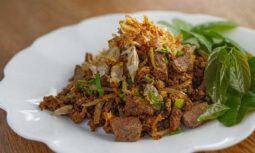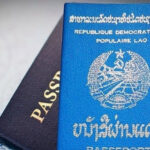Laap
Translated on most menus as simply a ‘meat salad,’ and also spelled in English commonly as larb or laab (laab or laap would be the most phonetically accurate), laap is one of the ultimate staple Laos foods, a heavyweight. The word Laap actually refers to any meat prepared immediately after butchering. Always fresh, often eaten raw, this […]
Translated on most menus as simply a ‘meat salad,’ and also spelled in English commonly as larb or laab (laab or laap would be the most phonetically accurate), laap is one of the ultimate staple Laos foods, a heavyweight.
The word Laap actually refers to any meat prepared immediately after butchering. Always fresh, often eaten raw, this dish is a mainstay in the Laos local diet.
You can choose from any meat that the restaurant has available, but often a certain individual restaurant in Laos may specialize in pork laap, or fish laap.
The chef will often mince, then quickly fry (or keep it raw if you order the raw version) the meat while adding fish sauce, a garden full of fresh herbs (including Laos mint, cilantro, and green onions), lime juice, and toasted sticky rice powder. The rice powder is an ingredient that gives Laap its signature flavor.
All ingredients are mixed until everything is perfectly even. Local versions of Laos laap can also include bile, yes the digestive fluid, adding a unique bitterness to your plate of laap.
Very different from Laap in North-East Thailand
As opposed to the laap you’ll find in Thailand (or Isaan more specifically), Laos laap is usually heavier on the herbs.
There’s also koi, a Laos mixed salad very similar to laap, but often made with slightly blanched meat or fish.

OUTSTANDING PLATE OF LAAP IN VIENTIANE, LAOS




